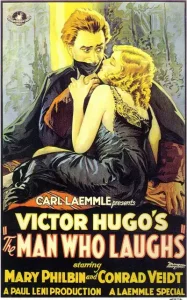Eternal Smile, Eternal Pain: How 'The Man Who Laughs' (1928) Forged a Gothic Masterpiece and Inspired a Comic Legend!
The Man Who Laughs
(USA, 1928, Paul Leni, 110 minutes)
In the twilight of the silent film era, as Hollywood began to embrace its own brand of gothic melodrama and horror, Universal Pictures was perfecting its formula for captivating monster tales, drawing heavily on the visual legacy of German Expressionism. It was within this rich context that The Man Who Laughs (1928), directed by the German émigré Paul Leni, emerged as a truly unique and visually stunning masterpiece. This film isn't just a historical curiosity; it's a deeply moving and often terrifying romantic drama that left an indelible mark on cinematic iconography. Its haunting central character, with a perpetually carved smile, became a chilling symbol of tragedy and resilience, subtly influencing popular culture for decades to come. The film beautifully bridges the gap between grand silent era spectacle and the emerging psychological depth of talkies, solidifying its place as an enduring, influential cult classic.
The film plunges us into 17th-century England, amidst a world of grotesque injustice and aristocratic cruelty. Gwynplaine (Conrad Veidt) is a young man whose face was surgically mutilated in childhood by King James II's court jester, leaving him with a permanent, horrifying grin. Abandoned, he is rescued and raised by the kind-hearted philosopher Ursus (George Siegmann) and falls deeply in love with Dea (Mary Philbin), a beautiful blind girl who cannot see his disfigurement. Their idyllic, though impoverished, life as traveling performers is shattered when Gwynplaine discovers his noble birthright, thrusting him into a world of courtly intrigue and political machinations. What unfolds is a poignant, tragic romance, as Gwynplaine struggles with his monstrous appearance, the cruel whims of fate, and the burning desire to be accepted for who he truly is. Conrad Veidt's haunting performance, combined with Paul Leni's atmospheric direction, creates a deeply empathetic portrayal of a man trapped between his grotesque facade and his noble soul.
Director: Paul Leni.
Cast: Conrad Veidt as Gwynplaine, Mary Philbin as Dea, Olga Baclanova as Duchess Josiana, and George Siegmann as Dr. Hardquanonne (Ursus in some versions).
Special Info/Trivia: The Man Who Laughs is based on Victor Hugo's 1869 novel of the same name. Conrad Veidt's iconic, permanently grinning facial makeup was created by Jack Pierce (uncredited) and is widely cited as the primary visual inspiration for the Joker character in Batman comics. The film was directed by Paul Leni, a key figure in German Expressionist cinema who brought his visual flair to Hollywood. It was produced by Universal Pictures during their "golden age" of horror films. The film features a Movietone synchronized score and sound effects, making it a "part-talkie" on the cusp of the sound era.

